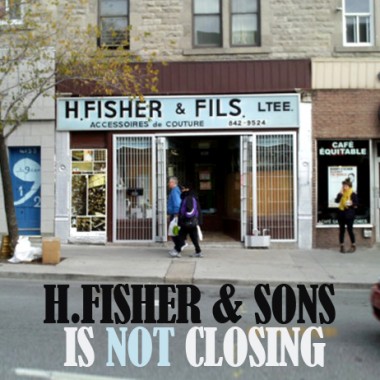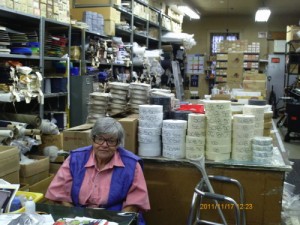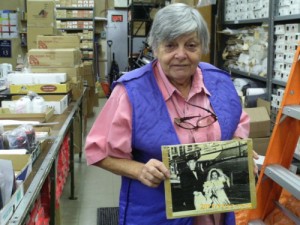
There’s a store on St. Laurent Boulevard that I’ve passed literally hundreds of times without knowing what it sold. All I knew was the sign. “H. Fisher & Fils,” I read from a window seat on the 55 bus, through a heavy snow. “H. Fisher & Fils,” leaving my new girlfriend’s house, wonderfully dazed, on a crisp fall morning. “H. Fisher & Fils,” stumbling home from some Mile End party, the sign just a vague blueish blur.
I recently heard that the Fisher store was going out of business, and thought it was as good a time as any to see what it was all about.
Walking into the empty store just before closing time (3 p.m.), I was met by a stout older woman, on her feet before I’d closed the door. She had a round face, crowned with a gray mop-top. The two hemispheres of her purple vest were united by an oversized white safety pin.
I’d called the store beforehand to ask if I could drop by.
“I didn’t get to tell you before you got off the phone, you were talking so quickly,” the woman said. “The store’s not closing.”
Opened in 1921, H. Fisher & Fils turns out to be an old-fashioned shop specializing in tailoring and sewing supplies. Esther Fisher assumed ownership and management around 18 years ago when her husband, the son of the original owner, died, and none of her kids wanted to take it over. With nothing else to do with her widowhood, Mrs. Fisher immersed herself in the business.

She said she had no idea why anyone would think the store was closing, and that she intended to work until her health no longer allowed it. Fortunately (or unfortunately, for whatever enemies Mrs. Fisher may have in the sewing supplies business), she’s doing just fine.
It became obvious to me very quickly that Mrs. Fisher would be interesting to interview, even though the store’s not closing yet (may she live to 120). Before that could happen, though, she said I had to watch a short DVD a few Concordia students made a few years ago about her and the store. Only then, she insisted, would I have a good enough background to ask good questions. Not exactly looking to argue with an 80-something businesswoman with more than a little zest in her yet, I watched the film, “Bits and Pieces of Mrs. Fisher,” over dinner one night last weekend, and came into the store early (as requested), ready with my questions.
RK: Where did you live in the neighbourhood? Where did you go to school?
EF: I was born in Montreal 82 ½ years ago. I’ve lived in the Plateau area all my life, lived at Clark and Marie-Anne. I went to school at Bancroft and then I went to Commercial, and then worked. Then I met my husband. He lived here upstairs, and we got married, and I lived upstairs for awhile after the war, because there were no homes. And then when the children came we moved out to Ville St. Laurent in 1949 or 1950, around then.
RK: Were you some of the first ones to move out there?
EF: It was just being built, and we had to walk to the nearest bus. It was very primitive, but we knew the schools were coming up, we knew the shul was coming up, so we were pioneering there, because there were no homes after the war, no telephones, no homes, it was really very difficult.
RK: When did you meet your husband? Did he already have the store then, had his father passed away?
EF: His father still had the store. My husband had gone into the air force, I met him after he was discharged. But I knew him from the neighbourhood. And then we got married, moved to Ville St. Laurent when the children came. He had some part of the business before, but when his father passed away he inherited it. And he ran it ever since, and when he passed away 18 years ago I was thrust into it.
RK: How has the store changed since you’ve been around?
EF: It was the same as you see it now, but they had more stuff. I kind of made it so I can handle it, it was too big for me. There were too many items. When you walked into this store, you could buy everything to make your suit, from the cloth right down to the buttons. And I’ve eliminated the cloth, so you have to get your cloth elsewhere, but anything else you can buy here.
RK: Do you have any memory of knowing about the store before you met your husband?
EF: No, because I wasn’t in the tailoring business. Even now, people can walk by our place a hundred times, and unless they know the address, they’ll miss it, because we don’t advertise, we’re very low-key.
RK: What was the street like back then?
EF: Oh, it was all Jewish, of course. And it was with streetcars and there was a market where the park is now [at Rachel and St. Laurent], and we used to buy our fruits and vegetables there, and our chickens [laughs]. Then it became a parking lot, the city took over, and now it’s a park.
RK: Any other ways the street is different?
EF: Oh yeah, it’s completely different. It became a heritage street, where you couldn’t touch the fronts. Who came after the Jews? Greeks came, and then the Portuguese came. So it’s now it’s predominantly Portuguese. And it’s becoming Lebanese, they’re making food and coffee shops and things like that.
RK: Are you noticing a renewed interest in the history of the old Jewish neighbourhood and of your store?
EF: Yes, more people are coming in. Even the government is interested in this store and in Schreter’s from the old way we do business, since we didn’t modernize.
RK: Are you nostalgic for the old days, with the store and with the street?
EF: Well I’m nostalgic where my store is concerned, because I don’t want to give it up. I’m 82, I’m still chugging along, have no intention of giving it up, unless health reasons make me give it up. And I feel that when I’m gone that will be the end of an era with this store, because there’s no one to take it over, and you can’t sell a store like this, because you need an awful lot of capital to keep the stock. But over 80 years, the accumulation, and every year a little more, it’s doable for me. It doesn’t pay anybody to put that kind of capital into this business, they can find other things to put it in and make a better return.

I think it’s a way of the past. There used to be like 9 or 10 of my store, and they’re all gone, because their children didn’t want to take it over. And this one also will be a postcard for the business when I’m gone, because my children won’t take it over.
________________________________________________________
This story was written by Ricky Kreitner and reposted from the Third Solitudes Series, the blog of The Interactive Museum of Jewish Montreal.






2 Responses to H. Fisher & Sons is Not Closing